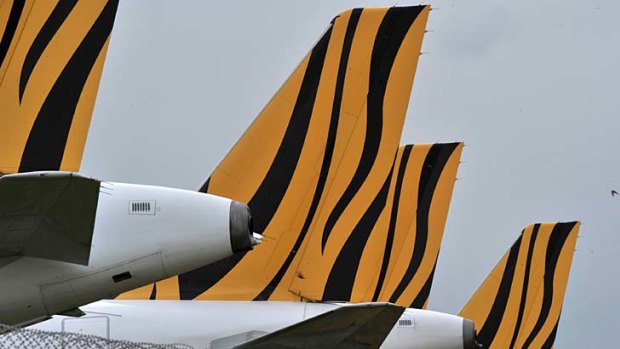By Matt O'sullivan
TIGER Airways faces millions of dollars in break fees on long-term aircraft leasing agreements if it decides to quit the Australian domestic market following its forced grounding.
The large cost of pulling out of Australia due to complicated lease contracts increases the pressure on Tiger to do its utmost to persuade the air-safety regulator to allow it to fly here again.

Observers feel we have not seen the end of Tiger Airways just yet.Credit: Michael Clayton-Jones
Most - if not all - of Tiger's 10 A320 aircraft based in Australia are cross-collateralised, which means that if it pulls out of this country its Singaporean parent will be liable for breaking lease agreements. It is also likely to have to meet tax liabilities in Australia.
Many of Tiger's Australian aircraft are leased from Royal Bank of Scotland and US aircraft leasing company CIT under 12-year agreements which require them to be flown here.
It is believed it would cost several million dollars per aircraft to unwind the leasing contracts to allow them to be redeployed to Tiger's Singapore base. ''It is expensive for them to get out. That is why the shareholders have to tell Tony [Davis] to get in there and fight,'' an insider said.
Yesterday Qantas chief executive Alan Joyce said he expected Tiger to continue to operate in Australia despite the brand damage caused by its forced grounding, although he suggested it would be difficult for Tiger to redeploy its 10 Airbus A320 aircraft elsewhere.
Shares in Qantas and Virgin Australia have rallied since the Civil Aviation Safety Authority grounded Tiger on July 1 due to safety concerns. Tiger has about a 5 per cent share of the domestic travel market.
''I can't see an alternative to Tiger redeploying a lot of the aircraft into Asia at this stage,'' Mr Joyce told the ABC's Inside Business.
''There is a big issue in Tiger's business model in being successful if it only has Singapore as a base. They need to show that they can make it work in multiple areas. They need to get the business back in operation here to be perceived as a pan-Asian brand.''
The grounding of Tiger, the first of an entire airline in Australia, has left many speculating that it is only a matter of time before it is forced to pull out.
But the cost of exiting, and the Singapore establishment's desire to maintain a strong presence in the Australian market, makes it unlikely Tiger will leave without a fight. Singapore Airlines still has a 33 per cent stake in the airline despite reducing its holdings when Tiger was floated early last year.
Other insiders say Tiger would have already ceased operations if it had wanted to pull out, rather than devoting resources to resolving the safety problems.
A Tiger spokeswoman would not comment on the leasing agreements because they were ''commercially sensitive'', but she insisted that the airline was ''definitely committed to Australia''.
Shares in Tiger fell 12 per cent last week due to the grounding of its Australian operations, closing on Friday at $S1.04 (A79¢).
US fund manager The Capital Group Companies has reduced its stake in Tiger from about 8 per cent to 5.9 per cent. Capital Group is also a major shareholder in Qantas.
Analysts have estimated that the grounding is costing Tiger at least $2 million a week.
Even before the latest crisis, Tiger had chalked up more than $80 million of accumulated losses in Australia since launching services in 2007.